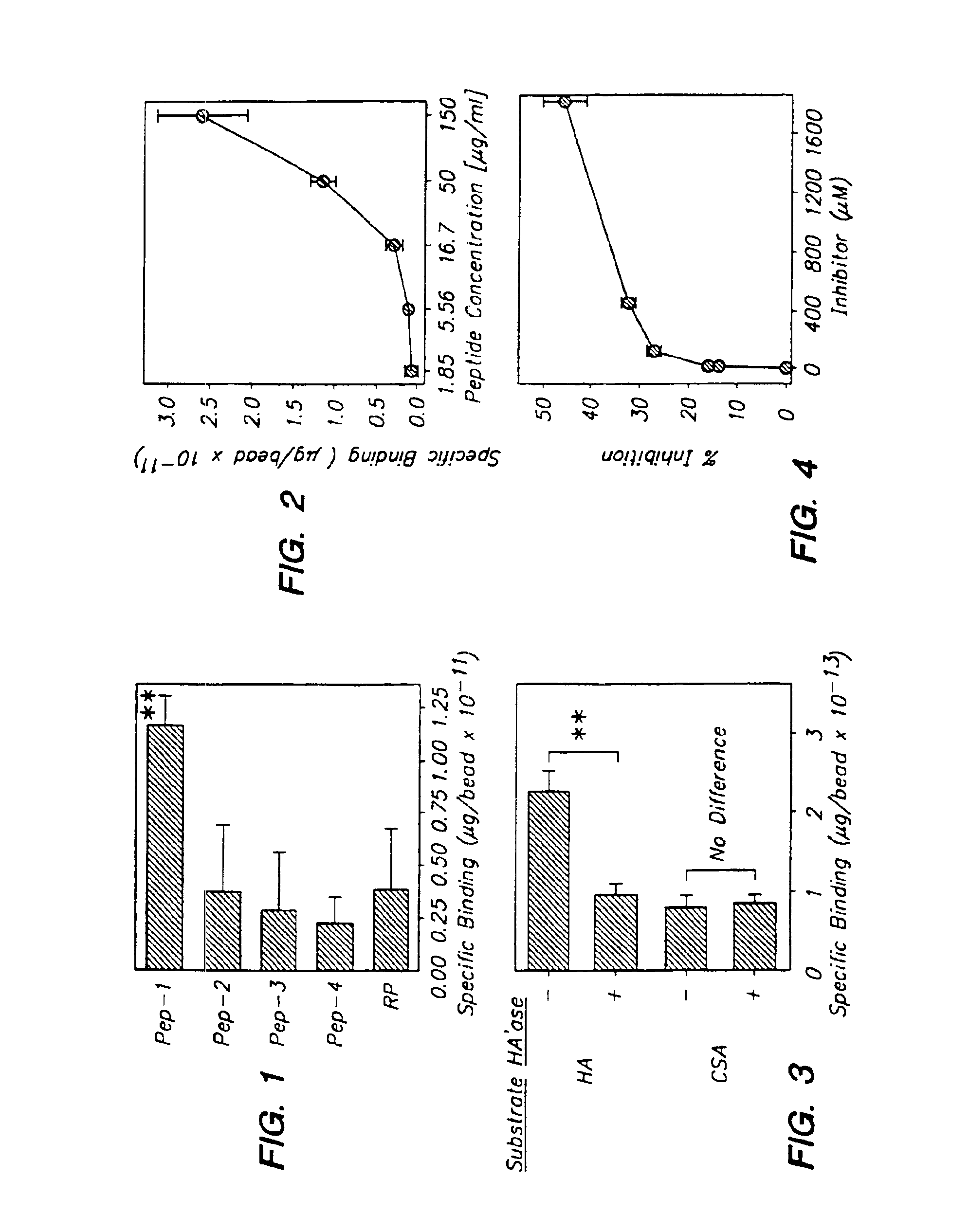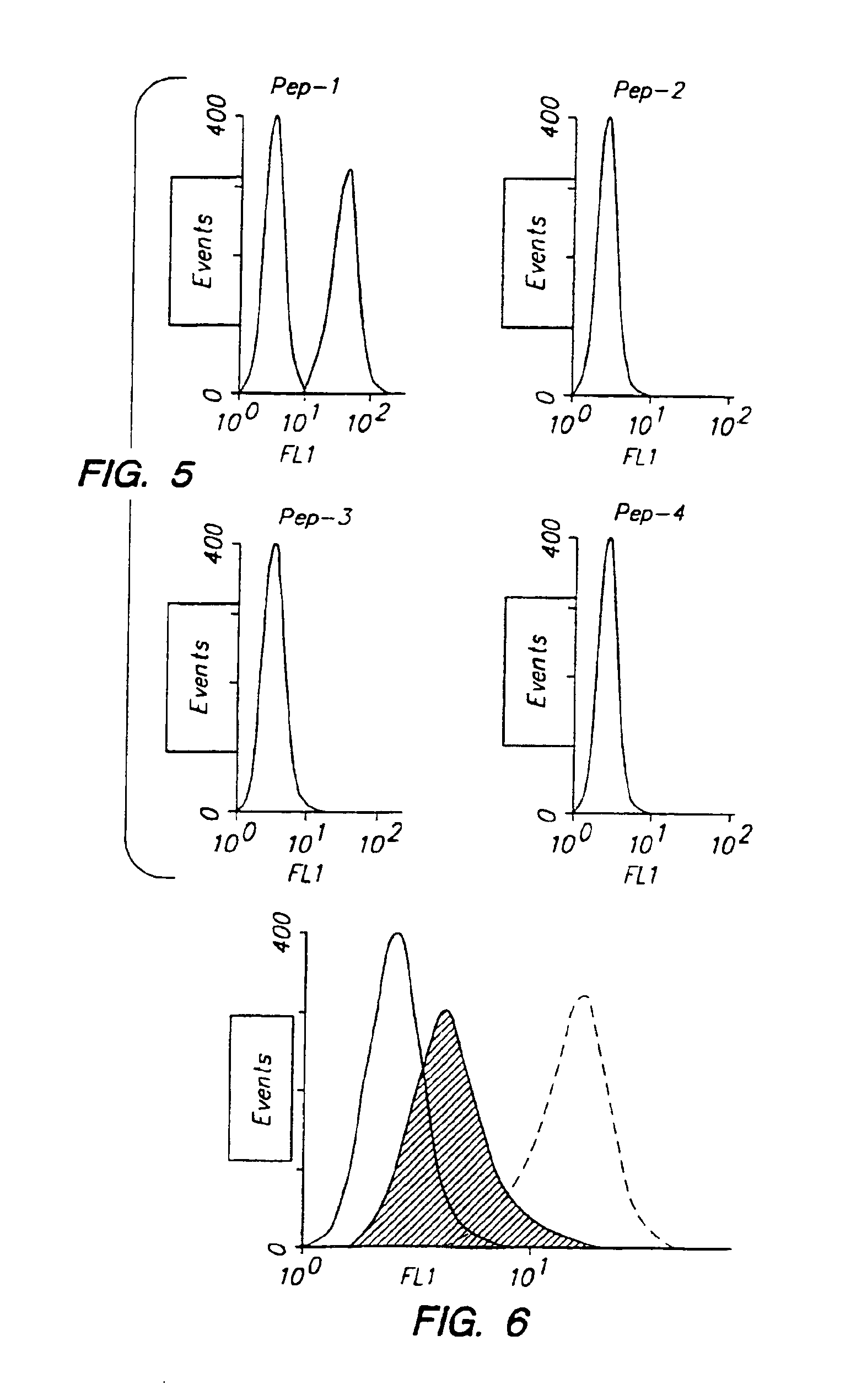Modulators of polysaccharides and uses thereof
a polysaccharide and polysaccharide technology, applied in the field of peptide inhibitors, can solve the problems of difficult to develop inhibitors or probes of glycosaminoglycans, and are near non-antigenic, and achieve the effect of cost-effective production
- Summary
- Abstract
- Description
- Claims
- Application Information
AI Technical Summary
Benefits of technology
Problems solved by technology
Method used
Image
Examples
example 1
Isolation of HA-Specific Peptides
[0112]A phage library was constructed consisting of random 12-mer peptides fused to a minor coat protein (pIII) of the M13 phage. The estimated complexity of the library was determined to be about 109. Phage clones (1011 pfu) were then incubated on polystyrene tissue culture plates that had been coated with HA and counter-coated with BSA.
[0113]The 35 mm tissue culture plates were coated overnight at 4° C. with 2.5 mg / ml HA in PBS and then washed three times with PBS (2 min / wash). To block the non-specific binding sites, the plate was then counter-coated with 1% heat-denatured BSA in PBS for 30 min at room temperature. After three additional washes with PBS, the phage (1011 pfu) suspended in PBS was added to the HA-coated / BSA-counter coated plate. After 60 min incubation at room temperature, the unbound phage clones were removed by extensive wash; 10 times with PBS alone and 10 additional times with 0.1% Tween20 in PBS for 30 seconds each wash. The pl...
example 2
Binding Efficacy of the Isolated HA-Specific Peptides
[0117]Each of the four isolated HA-binding peptides (Peptides 1 through 4) and a “random” control peptide (selected from phage clones which failed to bind to HA) were synthesized to examine their specificity to HA. The random peptide sequence was SATPASAPYPLAGGGS (SEQ ID NO:6). The peptides tested also had a spacer sequence of GGGS at the carboxy terminus of the peptide.
[0118]Phage clones expressing each of the HA-binding peptides were incubated of two hours on HA-coated polystyrene plates. After extensive washing, phage that were still bound to the HA substrate were eluted by HAase treatment and the isolated phage were titrated to determine the extent of each peptide's binding to HA. Peptide 1 showed the most significant binding to both HA-coated plates and native HA molecules expressed on keratinocytes.
[0119]Each of the indicated 12-mer peptides was labeled with 125I and tested at 50 μg / ml for the binding to HA-coated beads. The...
example 3
Binding of Peptide 1 to Native HA Molecule on Endothelial Cells
[0122]Biotinylated Peptide 1 through Peptide 4 were tested at 62 μM for the binding to SVEC 10-40 endothelial cells. As a control, cells were incubated with biotinylated RP. After washing to remove unbound peptides, the cells were incubated with streptavidin-FITC and subjected to FACS analyses (FIG. 5). Peptide 1 displayed a much higher affinity to the endothelial cells than either RP or Peptides 2-4.
[0123]SVEC cells were then treated with hyaluronidase (330 U / ml) or mock-treated (open histogram with broken lines) prior to incubation with biotinylated Peptide 1 (62 μM) or biotinylated RP. The binding efficiency of Peptide 1 was dramatically reduced in the HAase treated cells as compared to both the mock treated cells (FIG. 6).
PUM
| Property | Measurement | Unit |
|---|---|---|
| time periods | aaaaa | aaaaa |
| boiling points | aaaaa | aaaaa |
| boiling points | aaaaa | aaaaa |
Abstract
Description
Claims
Application Information
 Login to View More
Login to View More - R&D
- Intellectual Property
- Life Sciences
- Materials
- Tech Scout
- Unparalleled Data Quality
- Higher Quality Content
- 60% Fewer Hallucinations
Browse by: Latest US Patents, China's latest patents, Technical Efficacy Thesaurus, Application Domain, Technology Topic, Popular Technical Reports.
© 2025 PatSnap. All rights reserved.Legal|Privacy policy|Modern Slavery Act Transparency Statement|Sitemap|About US| Contact US: help@patsnap.com



